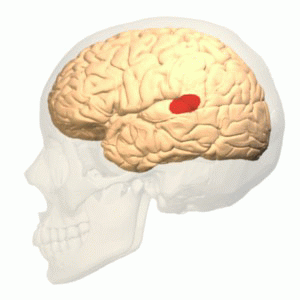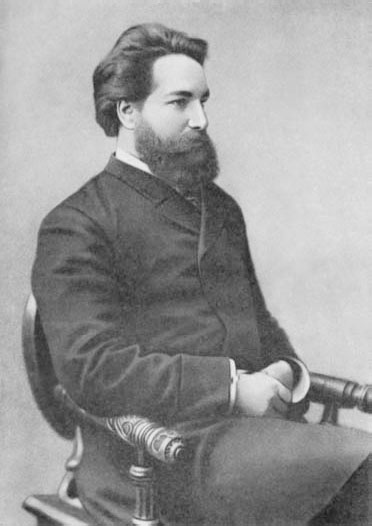|
Meynert
Theodor Hermann Meynert (15 June 1833 – 31 May 1892) was a German-Austrian psychiatrist, neuropathologist and anatomist born in Dresden. Meynert believed that disturbances in brain development could be a predisposition for psychiatric illness and that certain psychoses are reversible. In 1861 he earned his medical doctorate, and in 1875 became director of the psychiatric clinic associated with the University of Vienna. Some of his better known students in Vienna were Josef Breuer, Sigmund Freud, who in 1883 worked at Meynert's psychiatric clinic, and Julius Wagner-Jauregg, who introduced fever treatment for syphilis. Meynert later distanced himself from Freud because of the latter's involvement with practices such as hypnosis. Meynert also ridiculed Freud's idea of male hysteria; though some authors believe this to be due to his own hidden suffering of the illness, prompting a reconciliation with Freud near to his death. Other famous students of Meynert's were Russian neuropsychi ... [...More Info...] [...Related Items...] OR: [Wikipedia] [Google] [Baidu] |
Basal Optic Nucleus Of Meynert
The nucleus basalis, also known as the nucleus basalis of Meynert or nucleus basalis magnocellularis, is a group of neurons located mainly in the substantia innominata of the basal forebrain. Most neurons of the nucleus basalis are rich in the neurotransmitter acetylcholine, and they have widespread projections to the neocortex and other brain structures. Structure The nucleus basalis in humans is a somewhat diffuse collection of large cholinergic neurons in the basal forebrain. The main body of the nucleus basalis lies inferior to the anterior commissure and the globus pallidus, and lateral to the anterior hypothalamus in an area known as the substantia innominata. Rostrally, the nucleus basalis is continuous with the cholinergic neurons of the nucleus of the diagonal band of Broca. The nucleus basalis is thought to consist of several subdivisions based on the location of the cells and their projections to other brain regions. Occasional neurons belonging to the nucleus basa ... [...More Info...] [...Related Items...] OR: [Wikipedia] [Google] [Baidu] |
Carl Wernicke
Carl (or Karl) Wernicke (; ; 15 May 1848 – 15 June 1905) was a German physician, anatomist, psychiatrist and neuropathologist. He is known for his influential research into the pathological effects of specific forms of encephalopathy and also the study of receptive aphasia, both of which are commonly associated with Wernicke's name and referred to as Wernicke encephalopathy and Wernicke's aphasia, respectively. His research, along with that of Paul Broca, led to groundbreaking realizations of the localization of brain function, specifically in speech. As such, Wernicke's area (a.k.a. Wernicke's Speech Area) has been named after the scientist. Biography Wernicke was born on May 15, 1848, in Tarnowitz, a small town in Upper Silesia, Prussia, now Tarnowskie Góry, Poland. He obtained his secondary education at the gymnasium in Oppeln, which is a school near the university of Breslau. Wernicke then studied medicine at the University of Breslau and did graduate work studying la ... [...More Info...] [...Related Items...] OR: [Wikipedia] [Google] [Baidu] |
Substantia Innominata Of Meynert
The substantia innominata also innominate substance, or substantia innominata of Meynert (Latin for unnamed substance) is a series of layers in the human brain consisting partly of gray and partly of white matter, which lies below the anterior part of the thalamus and lentiform nucleus. It is included as part of the anterior perforated substance (as it appears to be perforated by many holes which are actually blood vessels). It is part of the basal forebrain structures and includes the nucleus basalis. A portion of the substantia innominata, below the globus pallidus is considered as part of the extended amygdala. Layers It consists of three layers, superior, middle, and inferior. * The ''superior layer'' is named the ansa lenticularis, and its fibers, derived from the medullary lamina of the lentiform nucleus, pass medially to end in the thalamus and subthalamic region, while others are said to end in the tegmentum and red nucleus. * The ''middle layer'' consists of nerve cells a ... [...More Info...] [...Related Items...] OR: [Wikipedia] [Google] [Baidu] |
Cytoarchitectonics Of The Cerebral Cortex
Cytoarchitecture (Greek '' κύτος''= "cell" + '' ἀρχιτεκτονική''= "architecture"), also known as cytoarchitectonics, is the study of the cellular composition of the central nervous system's tissues under the microscope. Cytoarchitectonics is one of the ways to parse the brain, by obtaining sections of the brain using a microtome and staining them with chemical agents which reveal where different neurons are located. The study of the parcellation of ''nerve fibers'' (primarily axons) into layers forms the subject of myeloarchitectonics ( History of the cerebral cytoarchitecture Defining cerebral cytoarchitecture began with the advent of —the science of slicin ...[...More Info...] [...Related Items...] OR: [Wikipedia] [Google] [Baidu] |
Auguste-Henri Forel
Auguste-Henri Forel (1 September 1848 – 27 July 1931) was a Swiss myrmecologist, neuroanatomist, psychiatrist and eugenicist, notable for his investigations into the structure of the human brain and that of ants. For example, he is considered a co-founder of the neuron theory. Forel is also known for his early contributions to sexology and psychology. From 1978 until 2000 Forel's image appeared on the 1000 Swiss franc banknote. Biography Born in villa ''La Gracieuse'', Morges, Switzerland, to Victor Forel a pious Swiss Calvinist and Pauline Morin, a French Huguenot he was brought up under a protective household. At the age of seven he began to take an interest in insects. He went to school at Morges and Lausanne before joining the medical school at Zurich. Forel had a diverse and mixed career as a thinker on many subjects. At Zurich he was inspired by the work of Bernhard von Gudden (1824-1886). In 1871 he went to Vienna and studied under Theodor Meynert (1833-1892) b ... [...More Info...] [...Related Items...] OR: [Wikipedia] [Google] [Baidu] |
Cytoarchitectonics
Cytoarchitecture (Greek '' κύτος''= "cell" + '' ἀρχιτεκτονική''= "architecture"), also known as cytoarchitectonics, is the study of the cellular composition of the central nervous system's tissues under the microscope. Cytoarchitectonics is one of the ways to parse the brain, by obtaining sections of the brain using a microtome and staining them with chemical agents which reveal where different neurons are located. The study of the parcellation of ''nerve fibers'' (primarily axons) into layers forms the subject of myeloarchitectonics ( History of the cerebral cytoarchitecture Defining cerebral cytoarchitecture began with the advent of —the science of slicing a ...[...More Info...] [...Related Items...] OR: [Wikipedia] [Google] [Baidu] |
Gabriel Anton
Gabriel Anton (28 July 1858 – 3 January 1933) was an Austrian neurology, neurologist and psychiatry, psychiatrist. He is primarily remembered for his studies of psychiatric conditions arising from damage to the cerebral cortex and the basal ganglia. Academic career He was a native of Žatec, Saaz, Kingdom of Bohemia, Bohemia, and in 1882 received his medical doctorate at Prague. In 1887 he traveled to Vienna in order to work with Theodor Meynert (1833–1892), who was to become an important influence to Anton's medical career. In 1891 he moved to Innsbruck, where he served as an associate professor of psychiatry and director of the university clinic. Later (1894), he relocated to the University of Graz as a full professor of psychiatry, and in 1905 succeeded Karl Wernicke (1848–1905) at the University of Halle. Contributions Anton is remembered for his pioneer contributions in the field of neurosurgery. In collaboration with surgeons Friedrich Gustav von Bramann (1854–19 ... [...More Info...] [...Related Items...] OR: [Wikipedia] [Google] [Baidu] |
Julius Wagner-Jauregg
Julius Wagner-Jauregg (; 7 March 1857 – 27 September 1940) was an Austrian physician, who won the Nobel Prize in Physiology or Medicine in 1927, and is the first psychiatrist to have done so. His Nobel award was "for his discovery of the therapeutic value of malariotherapy, malaria inoculation in the treatment of general paresis of the insane, dementia paralytica". Early life Julius Wagner-Jauregg was born Julius Wagner on 7 March 1857 in Wels, Upper Austria, the son of Adolph Johann Wagner and Ludovika Jauernigg Ranzoni."Physiology or medicine, 1922-1941" Jan Lindsten. World Scientific, 1999. p. 170. , . His family name was changed to "Wagner von Jauregg" when his father was given the title of "Ritter von Jauregg" ... [...More Info...] [...Related Items...] OR: [Wikipedia] [Google] [Baidu] |
Sergei Korsakoff
Sergei Sergeyevich Korsakov (russian: Серге́й Серге́евич Ко́рсаков; 22 January 1854, Gus-Khrustalny – 1 May 1900, Moscow) was a Russian neuropsychiatrist, known for his studies on alcoholic psychosis. His name is lent to the eponymous Korsakov's syndrome and Wernicke–Korsakov syndrome. Early life and education Sergei Korsakov was the first great Russian neuropsychiatrist. He studied medicine at the Moscow State University, graduated in 1875 and subsequently became a physician at the ''"Preobrazhenski"'' (russian: Преображенский) mental hospital. From 1876 to 1879, he gained postgraduate experience in the clinic for nervous diseases under Aleksei Kozhevnikov. His thesis ''Alcoholic Paralysis'' gained him a medical doctorate in 1887. File:Об алкогольном параличе (Ob alkogol’nom paraliche) - 1887.jpg, Ob alkogol’nom paraliche (Alcoholic Paralysis) - 1887 File:Об алкогольном паралич� ... [...More Info...] [...Related Items...] OR: [Wikipedia] [Google] [Baidu] |
Sigmund Freud
Sigmund Freud ( , ; born Sigismund Schlomo Freud; 6 May 1856 – 23 September 1939) was an Austrian neurologist and the founder of psychoanalysis, a clinical method for evaluating and treating psychopathology, pathologies explained as originating in conflicts in the Psyche (psychology), psyche, through dialogue between a patient and a psychoanalyst. Freud was born to Galician Jews, Galician Jewish parents in the Moravian town of Příbor, Freiberg, in the Austrian Empire. He qualified as a doctor of medicine in 1881 at the University of Vienna. Upon completing his habilitation in 1885, he was appointed a docent in neuropathology and became an affiliated professor in 1902. Freud lived and worked in Vienna, having set up his clinical practice there in 1886. In 1938, Freud left Austria to escape Nazi persecution. He died in exile in the United Kingdom in 1939. In founding psychoanalysis, Freud developed therapeutic techniques such as the use of free association (psychology), free a ... [...More Info...] [...Related Items...] OR: [Wikipedia] [Google] [Baidu] |
Austria
Austria, , bar, Östareich officially the Republic of Austria, is a country in the southern part of Central Europe, lying in the Eastern Alps. It is a federation of nine states, one of which is the capital, Vienna, the most populous city and state. A landlocked country, Austria is bordered by Germany to the northwest, the Czech Republic to the north, Slovakia to the northeast, Hungary to the east, Slovenia and Italy to the south, and Switzerland and Liechtenstein to the west. The country occupies an area of and has a population of 9 million. Austria emerged from the remnants of the Eastern and Hungarian March at the end of the first millennium. Originally a margraviate of Bavaria, it developed into a duchy of the Holy Roman Empire in 1156 and was later made an archduchy in 1453. In the 16th century, Vienna began serving as the empire's administrative capital and Austria thus became the heartland of the Habsburg monarchy. After the dissolution of th ... [...More Info...] [...Related Items...] OR: [Wikipedia] [Google] [Baidu] |
Forebrain
In the anatomy of the brain of vertebrates, the forebrain or prosencephalon is the rostral (forward-most) portion of the brain. The forebrain (prosencephalon), the midbrain (mesencephalon), and hindbrain (rhombencephalon) are the three primary brain vesicles during the early development of the nervous system. The forebrain controls body temperature, reproductive functions, eating, sleeping, and the display of emotions. At the five-vesicle stage, the forebrain separates into the diencephalon ( thalamus, hypothalamus, subthalamus, and epithalamus) and the telencephalon which develops into the cerebrum. The cerebrum consists of the cerebral cortex The cerebral cortex, also known as the cerebral mantle, is the outer layer of neural tissue of the cerebrum of the brain in humans and other mammals. The cerebral cortex mostly consists of the six-layered neocortex, with just 10% consisting o ..., underlying white matter, and the basal ganglia. In humans, by 5 weeks in ... [...More Info...] [...Related Items...] OR: [Wikipedia] [Google] [Baidu] |




_–_Gerd_Hruška.png)

